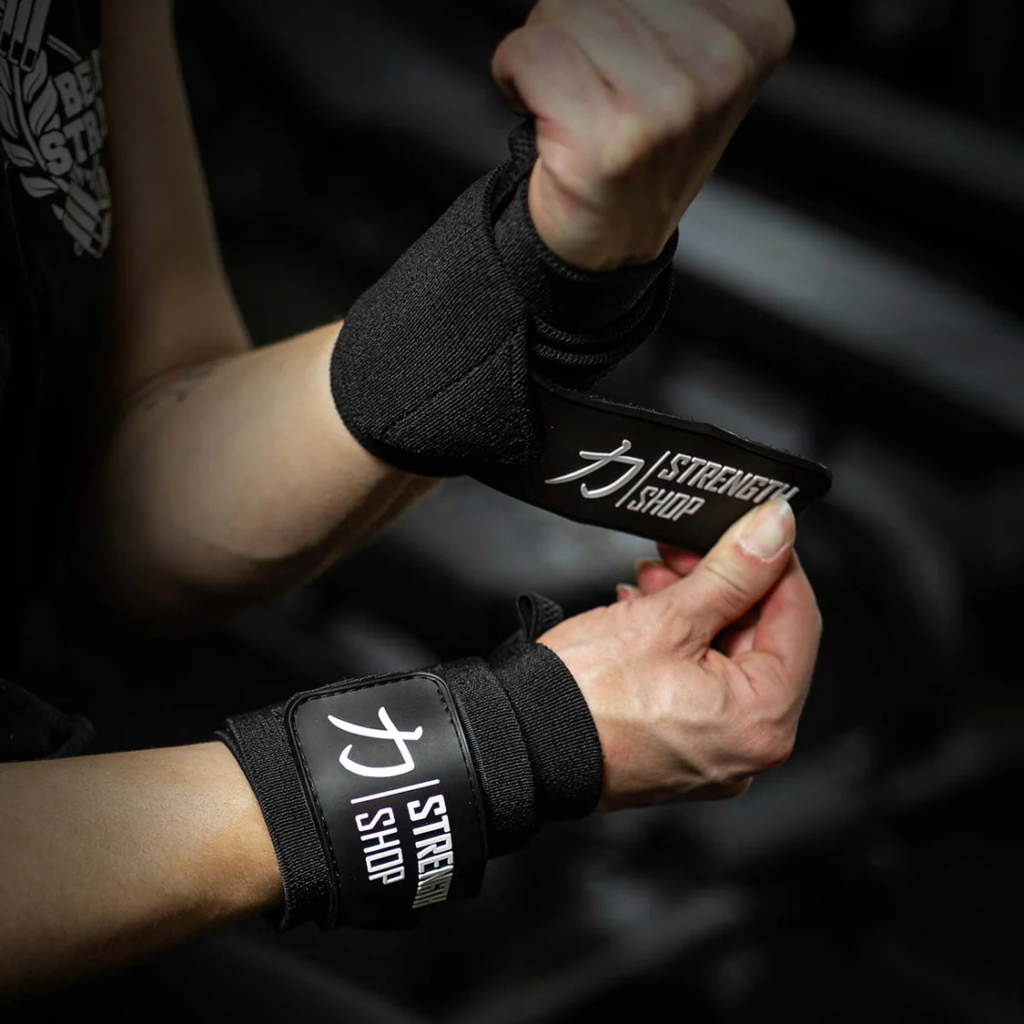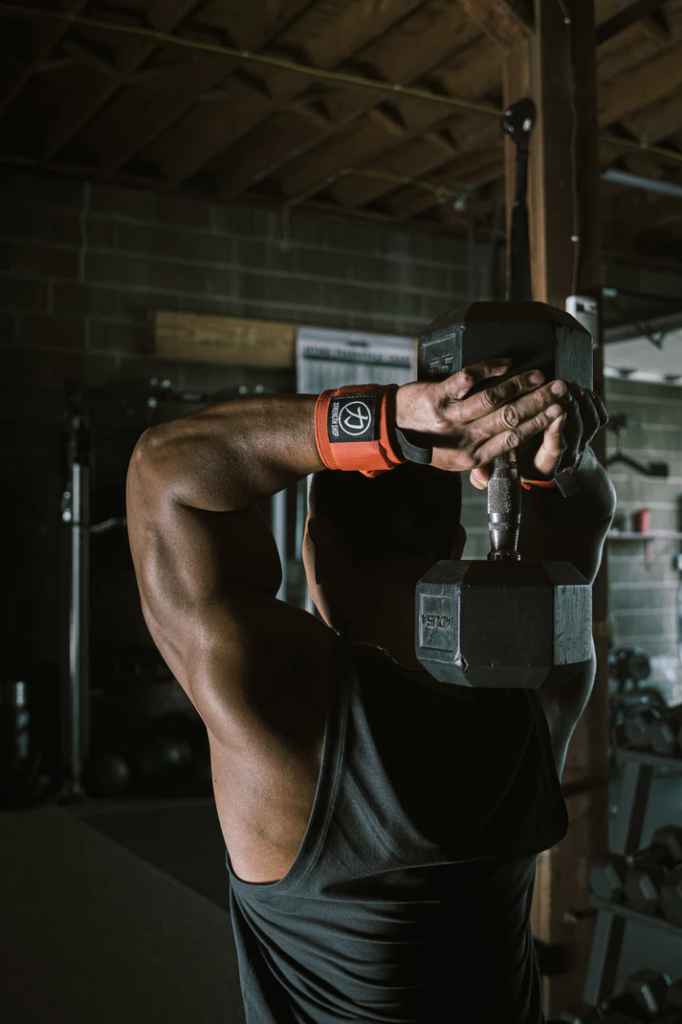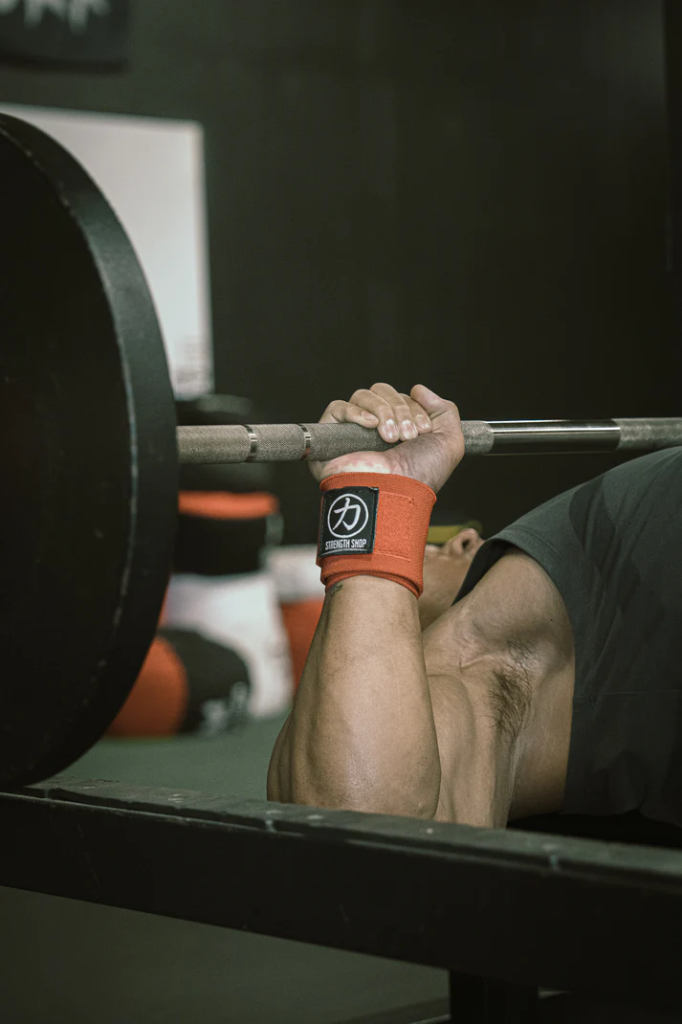Wrist wraps are an essential accessory for anyone serious about strength training. Whether you’re lifting heavy weights or performing high-repetition sets, the right support can protect your wrists, enhance performance, and reduce the risk of injury. In this post, we’ll explore the different types of wrist wraps available, their benefits, and how to choose the right one based on your specific training goals. Understanding these options will help you make an informed decision and get the most out of your workouts.
Table of Contents
What Are Wrist Wraps and Why Use Them?
Wrist wraps are essential accessories for anyone involved in weightlifting, powerlifting, CrossFit, or strength training. They are designed to provide support to the wrists during heavy lifts and exercises that put a lot of strain on the joints. Typically made from elastic materials or sturdy fabric, wrist wraps secure around the wrist with Velcro or a similar fastening mechanism, ensuring stability and reducing the risk of injury.
Wrist wraps are commonly used when performing exercises like bench presses, overhead presses, snatches, and clean and jerks, where the wrists bear significant weight. By limiting excessive wrist movement and stabilizing the joint, they help prevent hyperextension or sprains, making them a popular choice for athletes and fitness enthusiasts alike. Whether you’re lifting heavy weights or working on endurance, wrist wraps can enhance your performance and protect your wrists from strain.
Learn everything you need to know about wrist wraps in our ultimate guide here
Different Types of Wrist Wraps: An Overview
Wrist wraps come in various types, each designed for specific needs and exercises. Understanding the different types of wrist wraps can help you choose the best one for your training goals. Below are the most common types of wrist wraps and how they can benefit your workout.
Lightweight Wrist Wraps
Lightweight wrist wraps are typically made from a softer, more flexible material, offering moderate support without restricting movement. These wraps are thinner and often more breathable, making them ideal for less intense workouts or exercises where full wrist mobility is still important.
Best For:
Lightweight wrist wraps are best used in exercises that don’t place extreme stress on the wrists, such as light to moderate dumbbell work, kettlebell swings, and accessory exercises like triceps’ dips or push-ups.
| Pros: -Provides basic wrist support without being too restrictive. -Lightweight and comfortable, making them suitable for longer sessions. -Easy to put on and adjust quickly during workouts. | Cons: -Offers limited support for heavy lifts. Less durable compared to heavier-duty wraps. -Not ideal for powerlifting or exercises that involve maximum weights. |
Heavy-Duty Wrist Wraps
Heavy-duty wrist wraps are designed for maximum support during heavy lifts. These wraps are often made from thicker, stiffer material and provide excellent wrist stability by limiting movement. They are ideal for powerlifting and exercises where wrist protection is critical.
Best For:
Heavy-duty wraps are commonly used in heavy bench presses, squats, deadlifts, and other compound movements where the wrists need significant support to handle the load.
| Pros: -Provides excellent wrist stabilization for heavy, demanding lifts. -Reduces the risk of wrist injuries during high-load exercises. -Durable and long-lasting, even under heavy use. | Cons: -Restricts wrist movement, making it less suitable for exercises that require flexibility. -Can feel bulky and uncomfortable during longer training sessions. -May take longer to adjust and wrap properly. |

Stiff Wrist Wraps
Stiff wrist wraps are designed with a heavier fabric and less flexibility, giving maximum support and stability to the wrist. These are ideal for heavy lifting where wrist protection is a priority over mobility.
Best Exercises for Stiff Wrist Wraps:
- Powerlifting
- Heavy Bench Press
- Squats (for wrist support during barbell placement)
- Deadlifts
| Pros: -Provides strong support for heavy lifts -Reduces the risk of wrist injury during maximal efforts -Long-lasting durability | Cons: -Can feel restrictive and uncomfortable for dynamic movements -Limited wrist mobility |
Wrist Wraps of Different Lengths
Wrist wraps come in varying lengths, typically ranging from 12 inches to 36 inches. Shorter wraps offer lighter support, while longer wraps provide more stability and can be wrapped around the wrist multiple times for extra reinforcement. The length you choose should depend on your training style and the level of support you need.
Best For:
- Shorter wraps (12-18 inches) are great for exercises like push presses, kettlebell lifts, and general fitness routines that don’t require extreme wrist stability.
- Longer wraps (24-36 inches) are ideal for powerlifting, particularly in movements like the bench press or overhead presses where wrist protection is crucial.
| Pros: -Customizable support: Short wraps for lighter training, long wraps for maximum stability. -Versatile, allowing athletes to choose the right length for different workouts. -Provides options for varying wrist sizes and preferences. | Cons: -Longer wraps can be cumbersome and time-consuming to apply. -Shorter wraps may not offer enough support for heavy or complex lifts. -Requires practice to find the right balance of tightness and comfort with different lengths. |
Thumb Loop Wrist Wraps
Thumb loop wrist wraps feature a small loop that hooks around your thumb to help secure the wrap in place as you tighten it around your wrist. These wraps provide a secure fit and are easy to adjust during workouts.
Best Exercises for Thumb Loop Wrist Wraps:
- Powerlifting
- Olympic Lifts (Snatch, Clean & Jerk)
- Bench Press
| Pros: -Easy to put on and adjust -Provides extra stability for heavy lifts -Thumb loop ensures a secure fit | Cons: -Thumb loops can sometimes wear out -May cause discomfort around the thumb with prolonged use |

Cotton Wrist Wraps
Cotton wrist wraps are softer and less stiff than elastic or stiff wraps. They offer a lightweight option for athletes who need minimal wrist support during lighter workouts or endurance training.
Best Exercises for Cotton Wrist Wraps:
- Bodyweight Exercises
- Endurance Training
- Lightweight Dumbbell Workouts
- High-Rep Circuit Work
| Pros: -Soft and comfortable for extended wear -Provides light support and flexibility -Ideal for high-repetition training | Cons: -Limited wrist stability for heavy lifting -May wear down quickly with heavy use |
Elastic Wrist Wraps
Elastic wrist wraps are made from a blend of cotton and elastic fibres, offering a flexible fit that adjusts well to the wrist. They are versatile and provide a balance between support and mobility, making them suitable for most strength training exercises.
Best Exercises for Elastic Wrist Wraps:
- Bench Press
- Overhead Press
- Dumbbell Workouts
- Moderate Weightlifting
| Pros: -Comfortable and breathable -Provides moderate support without restricting movement -Suitable for a variety of exercises | Cons: -May not offer enough stiffness for very heavy lifts -Elasticity may wear out over time |
Velcro Wrist Wraps
Velcro wrist wraps are equipped with a Velcro strap for quick and easy fastening. They are highly convenient and adjustable, making them popular among lifters who need to frequently adjust their wrist wraps during training.
Best Exercises for Velcro Wrist Wraps:
- CrossFit Workouts
- Functional Fitness
- Olympic Lifting
| Pros: -Easy to adjust during a workout -Provides a customizable fit -Convenient for exercises requiring frequent adjustments | Cons: -Velcro may wear out with frequent use -May not offer as much support as stiffer wraps |
Elastic vs. Stiff Wrist Wraps: Which One to Choose?
The most common wrist wraps are elastic and stiff wrist wraps but when it comes to choosing between them, it’s essential to understand how each type serves different training goals and preferences. Both offer wrist support, but the level of flexibility and firmness varies significantly. Here’s a breakdown to help you decide which one suits your needs.
Elastic Wrist Wraps
Elastic wrist wraps are made from a blend of stretchable materials like cotton and elastic fibres, offering flexibility and a snug fit. They are ideal for general strength training and exercises that require a balance of wrist support and mobility.
When to Choose Elastic Wrist Wraps:
- Best For: Light to moderate weightlifting, bodybuilding, and CrossFit
- Exercises: Bench press, overhead press, dumbbell exercises, and accessory lifts
- Ideal For: Athletes looking for a versatile wrap that provides enough support without restricting wrist movement too much. If your training involves a mix of strength and dynamic movements, elastic wraps can adapt to various exercises.
| Pros: -Comfortable and flexible -Provides moderate support while maintaining wrist mobility -Versatile for different types of lifts | Cons: -May not provide enough support for very heavy lifting -Elasticity can wear out over time, reducing its effectiveness |
Stiff Wrist Wraps
Stiff wrist wraps are designed with minimal stretch, often made from denser materials, providing maximum wrist support and stability. These wraps are ideal for lifters focusing on heavy, maximal-effort lifts where wrist protection is a priority over mobility.
When to Choose Stiff Wrist Wraps:
- Best For: Powerlifting, weightlifting, and heavy compound movements
- Exercises: Squats, bench press, deadlifts, and any lift that puts a high load on the wrists
- Ideal For: Lifters who need maximum wrist stability for heavy weights. If your goal is to hit PRs (personal records) in exercises like the bench press or squat, stiff wraps are the go-to choice, providing firm support to prevent wrist injuries.
| Pros: -Excellent support for heavy lifts -Reduces wrist fatigue and strain during maximal efforts -Provides firm wrist stability and protection from injury | Cons: -Restricts wrist mobility, which can be uncomfortable for dynamic movements -Stiffer material may take longer to break in and feel comfortable |
Which One Should You Choose?
- For Beginners or General Lifters: Elastic wrist wraps are more versatile and comfortable, making them a better option if you’re new to strength training or looking for all-around support.
- For Heavy Lifters and Powerlifters: Stiff wrist wraps are the best choice if your goal is to lift heavy weights and you prioritize wrist protection over mobility.
- For CrossFit or Functional Fitness Athletes: Elastic wrist wraps provide the flexibility and mobility needed for a wide range of movements, from strength to endurance training.
In the end, the choice between elastic and stiff wrist wraps depends on your specific needs and training goals. If you need a balance of support and flexibility, go with elastic wraps. If you need maximum support for heavy lifts, stiff wrist wraps are the way to go.

How to Properly Use Wrist Wraps for Maximum Support
Using wrist wraps correctly can significantly enhance your performance and protect your joints during heavy lifting. Improper use, however, may lead to discomfort or even increase the risk of injury. Follow these steps to ensure you get the most out of your wraps and maximize the support they provide.
1. Position the Wrap Correctly
Start by placing the wrap around the base of your hand, just above the wrist joint. Avoid wrapping too high up the forearm or too low on the palm, as this can limit the range of motion or fail to provide adequate support where it’s needed most.
2. Secure the Thumb Loop (If Applicable)
If your wrap has a thumb loop, hook it around your thumb before tightening. This helps hold the wrap in place as you begin to secure it. Once the wrap is fully tightened, the thumb loop can usually be removed to avoid restriction during the exercise.
3. Tighten the Wrap for Your Desired Support
As you wind the material around your wrist, adjust the tightness to match the level of support needed for the specific lift. For heavy lifts like bench presses or deadlifts, you’ll want a snug fit that stabilizes the joint, but be careful not to wrap too tightly. Over-tightening can restrict blood flow or cause discomfort, especially during extended use.
For lighter exercises or those requiring more mobility, a looser wrap may be more appropriate. The key is to balance support with comfort, depending on the exercise.
4. Fasten Securely with Velcro or Straps
Once you’ve achieved the right level of tightness, secure the wrap using the Velcro or straps provided. Make sure the fastening is secure to avoid any loosening during the lift. A properly fastened wrap will stay in place without needing constant adjustment mid-workout.
5. Test Your Range of Motion
Before starting your set, test your range of motion by moving your wrist in different directions. You should feel supported but still able to perform the movement without discomfort. If you feel restricted or uncomfortable, adjust the wrap’s positioning or tightness until you achieve the right balance.
6. Use Wraps When Necessary
Wrist wraps are most beneficial for heavy lifts or exercises that place a lot of stress on the wrists. It’s not necessary to wear them for every workout. Reserve their use for lifts like bench presses, overhead presses, and other movements where wrist stability is key. This will help you avoid becoming too reliant on them, which can lead to weaker wrist joints over time.
Learn how to use wrist wraps in greater detail here
The Benefits of Wrist Wraps in Strength Training
In strength training, protecting your joints is crucial, especially as you increase the intensity and weight of your lifts. Wrapping your wrists during heavy exercises can provide multiple benefits that not only enhance performance but also reduce the risk of injury. Here are some of the key advantages of using these wraps.
Enhanced Joint Stability
One of the main benefits of using wraps is the additional stability they provide to your wrists. When lifting heavy weights, especially in exercises like bench presses or overhead movements, your wrists can be prone to bending or collapsing. Wraps help keep them in a stable, neutral position, ensuring better alignment and minimizing strain on the joint.
Injury Prevention
By stabilizing the joint and reducing excessive movement, wraps can significantly lower the risk of common wrist injuries such as strains or hyperextensions. They provide an extra layer of protection, particularly during compound lifts or when performing movements that place high stress on the wrists.
Increased Confidence in Lifting
When your wrists feel supported, you naturally gain more confidence in your ability to lift heavier. This added assurance can allow you to push your limits safely, helping you break through plateaus and hit new personal bests. Knowing your joints are protected enables you to focus on your form and the task at hand.
Improved Performance and Form
Wraps contribute to better overall form by keeping your wrists in the correct position. This stability helps you maintain proper technique, especially during heavy or high-repetition sets. Improved form not only prevents injury but also ensures you’re targeting the correct muscles during your lifts, maximizing the effectiveness of your workouts.
Reduces Wrist Fatigue
For lifters who perform high-rep sets or multiple heavy lifts, fatigue in the wrists can become a limiting factor. Wraps help reduce this fatigue by providing support, allowing you to lift for longer and with greater consistency. This can be particularly beneficial in exercises like bench presses or overhead presses, where wrist endurance can be a challenge.
Crucial for Powerlifters and Heavy Lifters
For those lifting maximal loads or engaging in powerlifting, wrist support becomes a necessity. The heavier the weight, the more strain placed on the joints. Wraps provide the support needed for these demanding lifts, helping to prevent injury and improve overall performance.
Learn how to correctly put on your wrist wraps here
Choosing the Right Wrist Wraps for Your Training Goals
Choosing the Right Wrist Wraps for Your Training Goals
Selecting the right wrist support depends largely on your specific training needs and the type of exercises you perform. Different types of wraps offer varying levels of support, flexibility, and comfort, so understanding how they match your goals is essential.
For General Weightlifting – Elastic Wrist Wraps
If you engage in general strength training or bodybuilding, where moderate weights and higher repetitions are the focus, elastic wraps are a great option. They offer a balance between support and mobility, providing just enough wrist stability without overly restricting movement. These are perfect for exercises like dumbbell presses, curls, and overhead lifts, where flexibility and comfort are still important.
For Powerlifting or Maximal Strength – Stiff Wraps
When your main goal is to lift as heavy as possible, such as in powerlifting or strongman competitions, stiffer wraps are the best choice. These provide maximum support for the wrist joint during heavy bench presses, deadlifts, and squats. The extra rigidity helps prevent any excessive movement, allowing you to focus on lifting safely and efficiently under heavy loads.
For CrossFit or Functional Fitness – Velcro Wrist Wraps
In CrossFit or functional training, where speed and movement variety are common, Velcro wraps with adjustable straps offer the flexibility needed for quick transitions. These wraps are easy to put on and adjust, making them ideal for high-intensity workouts that require frequent changes in exercise or weight. They provide enough support for lifts like snatches and clean-and-jerk movements, while also allowing for dynamic movements like push-ups or handstand holds.
For Endurance and Bodyweight Training – Lightweight Wrist Wraps
If your workouts involve higher repetitions or bodyweight exercises like push-ups or planks, lighter, more flexible wraps are ideal. Cotton wraps or less rigid versions will give you the support you need without restricting mobility or causing discomfort during prolonged training sessions. These wraps help prevent wrist fatigue while offering just enough support for lighter loads.
For Heavy Lifters with Joint Issues – Stiff Wraps
For those who already experience wrist pain or have a history of joint problems, it’s crucial to opt for more supportive wraps. Stiffer versions with reinforced material can provide the extra compression needed to protect sensitive joints during heavy lifts. Pairing these with proper wrist warm-ups and mobility exercises will help you lift with confidence while avoiding further injury.

Conclusion
Choosing the right support for your wrists can make a significant difference in both performance and injury prevention during strength training. Whether you’re lifting heavy in powerlifting, doing high-rep workouts, or focusing on general fitness, the type of wrap you use should match your goals. From providing stability and reducing fatigue to enhancing your lifting confidence, wrist wraps are a valuable tool in any strength training routine. By understanding the benefits and how to use them effectively, you can protect your joints and push your training to the next level.






2 Comments
Comments are closed.